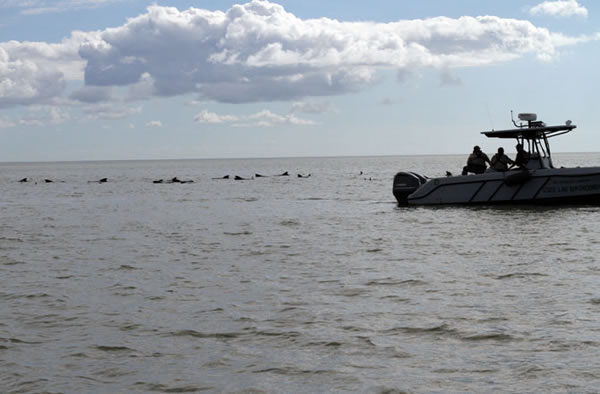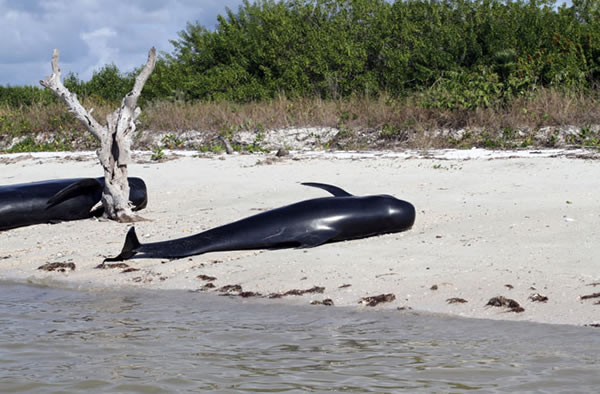How to Save Stranded Whales
Boats herding stranded pilot whales back to open ocean off the Florida Everglades.
Pilot whales that beached and died at the Florida Everglades.
Herding whales to safety is no easy task, but marine mammal experts have developed clever techniques that can save stranded whales, including many of those that wound up near Everglades National Park in Florida earlier this week.
Fishermen spotted 51 stranded pilot whales there on Tuesday. Among those whales, eleven died. Necropsy results are expected in a matter of weeks or perhaps months. Five whales remain missing, but the other 35 were herded offshore and are now in 12 feet of water.
"We are cautiously optimistic," NOAA spokeswoman Blair Mase told Discovery News and other media during a press conference Thursday afternoon.
She explained that pilot whales are normally in 900-1000 feet of water, "so they still have a while to go." As of Thursday evening, the whales were near Clover Key, 15 miles offshore, and appeared to be headed in the right direction away from land.
A coordinated effort involving the Coast Guard, NOAA Fisheries, the Florida Fish and Wildlife Conservation Commission, Marine Mammal Conservancy and Marine Animal Rescue Society deployed boats into the water. Via strategic maneuvers, the boats herded the whales away from shore and are now continuing to "escort" them back to safety.
CT Harry, assistant stranding coordinator at the International Fund for Animal Welfare, explained that "two or three vessels usually coordinate their movements in order to herd marine mammals, such as pilot whales. Together, the boats form a horseshoe shape in the water (surrounding the whales) and move in unison or in a zigzag motion."
He said rescue teams sometimes also release a water-activated "ping" device to encourage stranded marine mammals to move away from shore. That was considered for use in Florida, but ultimately was not needed.
"It doesn't harm cetaceans, but they don't like the sounds that it makes," he said.
For pilot whales that beach themselves, or otherwise wind up out of water, their own massive body weight -- up to around 6,600 pounds for adults -- could put pressure on their organs when unsupported by sufficient water. Janelle Schuh, stranding coordinator for Mystic Aquarium said that rescuers might therefore attempt to dig pressure-relieving trenches close to the whale's body, if it's on sand.
"It is also important to protect their skin from drying out, so we put wet cloths on their backs," she said.
As a last resort, teams will attempt to carry stranded marine mammals back to the water by placing them on stretchers. This is potentially very dangerous, though, both to the animal victims and to the rescuers. Schuh explained that the animals could die on the spot due to profound stress, or could hurt the people.
Human presence just in and of itself, especially when marine mammals are already out of their comfort zones, can skyrocket their stress levels.
"If you encounter a stranded marine mammal, please contact your local authorities immediately and only observe the animal or animals from a lengthy distance," Schuh advised.
NOAA Fisheries has organized the Marine Mammal Stranding Network. It lists the contact information for multiple different rescue organizations around the nation, with a few international organizations included as well. Most operate hotlines for reporting strandings.
It's likely that early reporting and a fast response from Mase and her team helped to save the 35 pilot whales now heading away from the Florida Everglades.(Dec 6, 2013 09:00 AM ET // by Jennifer Viegas)













